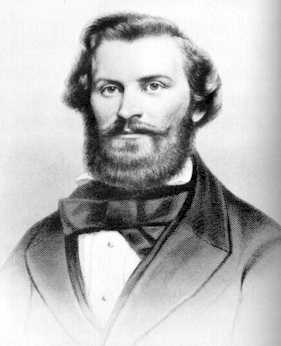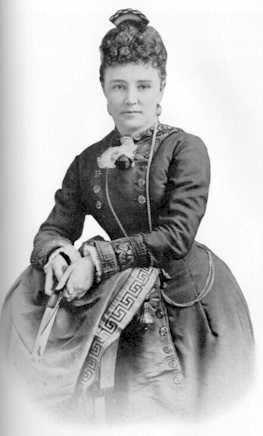|
Randal
McGavock: "Griffin, Take Care of Me!" by Rebecca Blackwell Drake
"We had marched up on a rise and were out in the open," spoke Griffin. "They (Union Army) were in the woods about one hundred yards in our front when they began to fire on us. We had been under fire about twenty minutes when I heard a ball strike something behind me. I have a dim remembrance of calling to God. It was my colonel. He was about to fall. I caught him and eased him down with his head in the shadow of a little bush. I knew he was going, and asked him if he had any message for his mother. His answer was, 'Griffin, take care of me! Griffin, take care of me!' I put my canteen to his lips, but he was not conscious. He was shot through the left breast, and did not live more than five minutes." The battle raged on but Captain Griffin had given up the fight. Instead, he settled his attentions on his dead commander. First, he took a white linen handkerchief from McGavock's back hip pocket and dipped the handkerchief in his warn blood. He vowed - if he survived the war - that he would take the handkerchief back to the commander's mother, Louisa McGavock. Then, he collected what personal effects he could find on McGavock's body: a signet ring, a gold watch and a few papers. The papers turned out to be a diary relating McGavock's final journal. After the gunfire ceased and the Confederate troops were defeated, Captain Griffin and other captured Confederate soldiers marched into Raymond and were taken prisoners of war. The next day the Union Army issued them a brief parole to help bury their fallen comrades. "Rough wooden coffins were hastily nailed together," Griffin recalled, "and loaded on a hired wagon." As the wagon proceeded toward the gravesite, a small cortege of townspeople and a ragged squad of Confederate prisoners accompanied the procession. After the burial, Griffin made a mental note of the exact site of Colonel McGavock's grave. If he survived the war, he would return the personal possessions he had saved for McGavock's family. He would also tell them where their son was buried. One month after the Battle of Raymond, Captain Griffin was placed on a Union boat with other Confederate prisoners and transported to Memphis. While docked in Memphis, he managed to escape and began searching for Grundy McGavock, a brother of Randal McGavock, who lived in Memphis. After locating Grundy, he related all the details of McGavock's death during the Battle of Raymond. Before departing, he turned over all of McGavock's personal effects and told Grundy where his brother's body was buried.
It was a sad Grundy McGavock who wrote the news of Brother Randal's death to family members' back in Nashville. When the news reached home, a younger brother wrote in his diary, "Letter from brother Grundy, Memphis, June 3rd, brings certain intelligence of Brother Randal's death. States that he has his seal ring and knows where he is buried." Several weeks later, McGavock's sister, Ann Dickinson, and her husband, Judge Dickinson, traveled to Raymond to find the grave that Captain Griffin had described. After locating the grave, they arranged to have McGavock's remains moved to their home in Columbus, Mississippi. Finally, on July 29, 1863, funeral services were held for Lt. Colonel Randal McGavock. Three years later, after the close of the war, McGavock's body was moved once again. The final move was to the family vault at Mt. Olivet - the family home in Nashville. The Nashville Dispatch ran a notice on March 16, 1866 saying, "Yesterday evening, the remains of our late fellow citizen, R.W. McGavock, who was a Lieutenant Colonel in the Confederate Army, and was killed in one of the engagements with General Grant's forces a little before the taking of Vicksburg, was brought to this city for re-interment. Col. McGavock was a Mayor of Nashville in 1858 and filled the office with signal ability. He was a citizen widely known and highly esteemed." Many years later, Colonel McGavock's personal journal, rescued by Captain Pat Griffin from the battlefield in Raymond, was turned into book form. The book, Pen and Sword, recalls the life and journals of the handsome red-headed colonel whose life ended on a battlefield far away from home. In the end, when he uttered his last words, "Griffin, Take Care of Me," his captain did just that. Not only was Randal McGavock's body returned home but the portrait of a Confederate solider was preserved forever.
Source: Pen and Sword, The Life and Journals of Colonel Randal McGavock, edited by Herschel Gower and Jack Allen, Published and copyrighted by the Tennessee Historical Commission, 1959-1960. Used with permission. Editor's note: Patrick Griffin, 10th Tennessee, was a 19-year-old soldier who was awed by his commanding officer, Col. Randal McGavock. Historians now agree that he could have fabricated many of his stories.
Click here to view Jerry McWilliams' portrait of Randal McGavock and Patrick Griffin | Home | Grant's March | Gregg's March | Battle of Raymond | Order of Battle | Commanders | Soldiers Who Fought | Diaries & Accounts | Copyright (c) James and Rebecca Drake, 1998 - 2002. All Rights Reserved. |
 In 1905,
forty-two years after the Battle of Raymond, Captain Pat Griffin
recalled the death of his commander, Colonel Randal McGavock. The
memories he shared with other Confederate veterans were vivid and tinged
with sadness.
In 1905,
forty-two years after the Battle of Raymond, Captain Pat Griffin
recalled the death of his commander, Colonel Randal McGavock. The
memories he shared with other Confederate veterans were vivid and tinged
with sadness.
